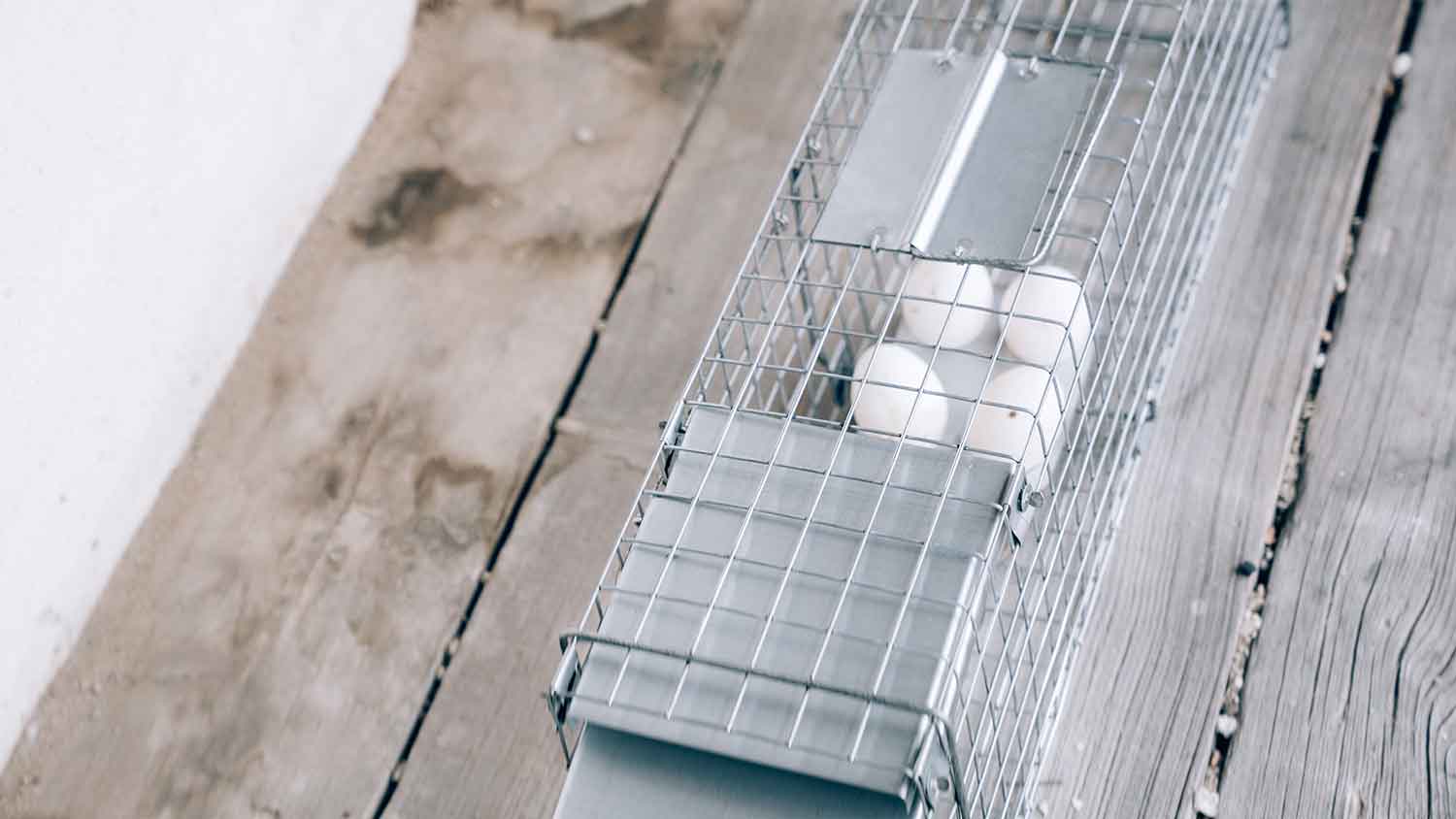
Raccoons on your property can cause a lot of damage to your home and yard. This guide breaks down raccoon removal costs so you can budget accordingly.
Just remember, they’d rather play dead than put up a fight


Possums are primarily nocturnal creatures that can be both helpful and a nuisance. They are excellent at controlling rodent and insect populations but notorious for raiding garbage cans and chewing up gardens. And let's not forget their sharp claws, enabling them to climb and wreak havoc on your home's siding and shingles. One solution for managing an infestation is knowing how to trap a possum humanely.
Before attempting to get rid of possums, check your state's wildlife laws. In many areas, removal is only allowed if they are causing property damage, and you may need a permit. Also, transporting and releasing possums is illegal in many municipalities. That's why, in many instances, it's best to call a possum removal expert who understands local guidelines.
The best capture method is a cage-style live trap, 32 to 42 inches long, designed to safely trap and hold the possum without causing injury. When handling the trap after capture, protective gear is a must to protect hands, arms, and legs from potential bites or scratches.
The best time to set possum traps is just before dusk. Since possums are active at night, this will increase your chances of catching them as they search for food.
These creatures are relatively easy to trap because they aren't very cautious. To determine where to place possum traps, look for signs of activity, such as tracks, droppings, disturbed trash, or claw marks.
Possums often stick to certain paths along fences or walls and like dark, quiet spots like sheds or crawl spaces. Setting traps near these areas or close to food sources like gardens or compost piles will increase your chances of catching one.

Possums love strong-smelling foods. Due to their pungent odor, canned fish like mackerel, slightly spoiled meat, and rotten eggs are great options. Sweet treats like marshmallows, apples, bananas, or berries also work well.
Possums are especially attracted to unusual scents—anything new or interesting will prompt them to investigate. This makes trying unusual types of possum bait, like aniseed dip or oil, highly effective.
Place the bait at the far end of the trap to ensure the possum has to enter completely to reach it. That way, the trap won’t trigger too early, which can lead to escape or, worse, injury to the animal.
Follow the manufacturer's instructions to ensure the trap is properly secured. Possums weigh 4 to 6 pounds but can be as heavy as 10. Anchoring the trap with a stake or a heavy object is an excellent way to stop the cage from tipping over if the possum struggles, preventing harm or escape.
Visit the trap at least once every 12 hours. If you have an extensive property, local guidelines may require that your trap has a label sharing your name, address, and permit number.

We don’t recommend DIYing this step. Safety is key when handling a trapped possum, so ensure anyone approaching the trap is wearing protective gear and using caution to avoid scaring the animal more than necessary.
Keep children and pets at a safe distance to avoid any potential mishaps. If you need to move the trap, hold it at arm's length so the possum's claws don't grab onto you. Draping a cloth over the cage can calm the possum during the process.
Relocating and releasing possums is illegal in many areas. However, in some states, it is legal for homeowners to euthanize these animals humanely, depending on the time of year.
Many homeowners who opt for DIY capture call an animal control expert for legal removal. Also, remember possums can play dead. You may think an animal died after capture, and then they wake, potentially complicating removal for inexperienced homeowners. It’s best to hire a professional at this stage.
Your decision ultimately relies on your comfort level and understanding of local wildlife laws. DIY trapping can be effective and inexpensive if you are up to speed on guidelines and humane methods and already own the equipment. However, it requires careful attention to detail, such as ensuring the possum's safety, checking traps regularly, and following legal guidelines for removal.
On the other hand, opting for professional possum removal takes the guesswork out of the process. These wildlife experts are trained to handle animals humanely and can navigate the legalities of the process, justifying the possum removal cost. They can also identify and address any entry points or attractants on your property, helping to prevent future issues.
From average costs to expert advice, get all the answers you need to get your job done.

Raccoons on your property can cause a lot of damage to your home and yard. This guide breaks down raccoon removal costs so you can budget accordingly.

When budgeting for possum removal costs, consider number of animals, location, method of removal, and whether you do it yourself or hire a professional.

When calculating wildlife removal costs, you’ll need to consider the type, size, and amount of animals. Our guide will show you the wildlife removal cost.

Scorpions are a common pest in warm, dry climates. Learn how to effectively deter, prevent, and kill scorpions in and around your home and property.

If your yard is filled with holes, we can teach you how to get rid of gophers and keep them away from your property so you can restore your landscape.

If there’s an animal in your vent, who do you call?. Here’s what to do if a critter gets loose in your HVAC system vents.